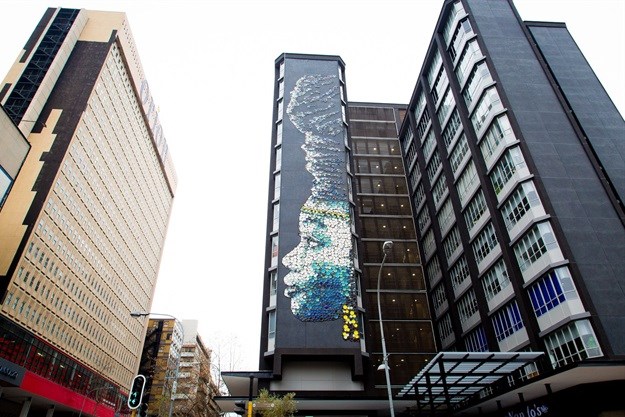





City Property commissioned the portrait as part of its commitment to the rejuvenation and urban renewal of the Johannesburg city centre.

“When we started the upgrade of the building, the building was covered with old mosaic style tiles. We investigated possible options including cladding, texture, and a public art piece. We wanted something that is proudly South African and speaks to the energy that encompasses Jozi,” says Jeffrey Wapnick, City Property MD.
“The architects approached renowned artist Hannelie Coetzee and her concept was tied back to the original mosaic on the building. We loved the modern spin on it while still embracing the history about the Ndebele people. We have always used public art to start conversations about inner city rejuvenation. We’ve done numerous pieces in Tshwane but this impressive mural is our first major public art contribution to the city of Johannesburg. Our substantial investment through the upgrade of this property and the mural on the façade speaks to our confidence in the area and the city,” continues Wapnick.
The 170m2 relief sculpture covers 65% of one wing of the commercial building and was created out of more than 2,000 plates, specialised tile adhesive, mesh, nails, and anchors. During her research, Coetzee discovered that the Ndzundza Ndebele lived in the Highveld from the 1630s until the late 1600s. Like the spirit of Johannesburg today, they embraced a cultural inclusivity which often welcomed other ethnicities. Traces of this lifestyle were discovered on pottery that dated from the 17th century and through oral history research.
Coetzee also studied Tshilidzi Mavhunga’s architectural graduate thesis focusing on hair salons in the city which brought to her attention how older traditional hairstyles are serving as inspiration for current, trendy hairstyles. Mavhunga shortlisted the trendiest hairstyle Instagrammers for Coetzee to consider. The Ndzundza/Nzunza portrait celebrates how hairstyles from different cultures are being rewoven and expressed in new and current ways.
“I had an idea of blending the historical elements of the Ndzundza with the city landscape,” says Coetzee.
“The use of the monochromatic blue and turquoise crockery plates, saucers and bowls make the mural more abstract. Accented elements are in yellow and white crockery. I sourced it from various potteries and ceramic factories. What makes it also quite unique is that the majority of the experts and artisans were mostly women – from the mosaic artists and assistants to the project manager and the electrical engineer. We thought it would be very appropriate to do the unveiling on Women’s Day as we celebrate the power, diversity, and excellence of women,” she adds.
Wapnick explained the complex planning process that was necessary to make sure the iconic artwork rose to its prominence on the side of the building.
“We were thrilled to work with Hannelie again. As a photographer, she understands depth, pixels, and composition, which is seen in her other work as well. We have worked with her in the past at the 012central precinct with public art pieces such as Tant Koek and Gill Marcus/Kindloos. We appreciate her creative process, her in-depth research and how she uses a piece of the research to produce a thought-provoking piece. This is what makes her such a remarkable and unique visual language artist.”
The successful installation was an easy task; the conceptual design took about three months and installation 10 weeks.
“The massive mural was laid out on a vacant floor at the building and the team had the challenge of working on a vertical sculpture in a confined space. Although pottery pieces were sourced, they had to manufacture the smaller pieces themselves from shards from the same pottery. Coetzee drew the outline of the woman on a grid, each piece with a unique code to fit onto the adhesive sheets. The grid pattern had to be attached in sections of not more than 500mm x 800mm at a time because of its weight.”
A team of more than 50 technical advisors collaborated to engineer the artwork on the façade. The relevant input from extensive projects team had to be considered. Besides the scale and weight of the art piece, the team had to consider how it would be affixed to the building, natural elements such as sun and hail, waterproofing, methodology, longevity and future maintenance.
As some saucers and bowls are faced down to facilitate specific tones, it had to be drilled into the wall, filled with adhesive and sealed afterwards. Screws, nuts, and bolts also had to be treated for rust and the team also had to consider how they would have to deal with the expansion joints of the building. Tile adhesive company TAL prepared 2.6 tonnes of bespoke charcoal adhesive with grout and water resistance properties. Customised bags were produced to ensure the team could work on the mural in sections without the adhesive hardening, resulting in limited waste.